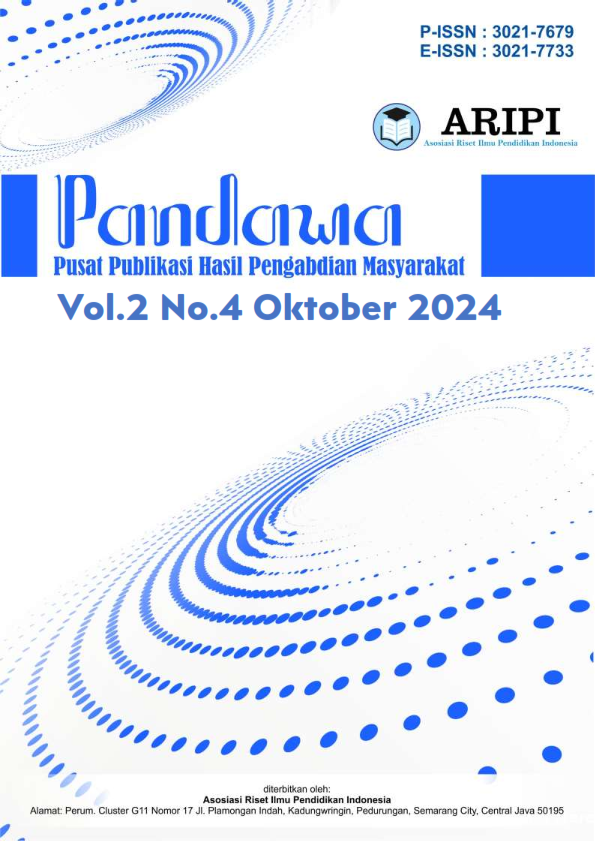Implementasi Pojok Literasi Sebagai Strategi Penigkatan Literasi Siswa di Lingkungan SDN 1 Tongka Kalimantan Tengah
DOI:
https://doi.org/10.61132/pandawa.v2i4.1312Keywords:
literacy corner, student literacy, elementary school, Central KalimantanAbstract
This community service program was implemented to address the low literacy levels among students in remote areas of Central Kalimantan, specifically at SDN 1 Tongka, Gunung Timang District, North Barito Regency. The main objective of the program was to implement a literacy corner as a strategy to improve student literacy and create a sustainable literacy ecosystem in the school environment. The method used included participatory and adaptive approaches, applying the concept of a "mobile literacy corner" adapted to the limitations of local space and resources. The program was carried out over 45 days, covering preparation, implementation, and evaluation phases. The results showed a significant increase in students' reading interest, with a 68% rise in the frequency of visits to the literacy corner. Pre-test and post-test evaluations indicated an average increase in students' literacy skills of 27%, particularly in reading comprehension and vocabulary mastery. Participatory observation revealed the formation of a stronger literacy culture in the school environment, characterized by student-initiated literacy discussions and increased use of references in academic tasks. The program also successfully developed an adaptive and contextual model for implementing literacy corners, which has the potential to be replicated in other remote areas of Indonesia.
Downloads
References
Archda, R., & Tumangger, J. (2019). Hulu-hilir penanggulangan stunting di Indonesia. https://mpra.ub.uni-muenchen.de/id/eprint/9761.
Ernawati, M. (2024). BKKBN Jatim Targetkan Prevalensi Stunting 13 Persen di Tahun 2024. Dinas Kominfo Provinsi Jawa Timur. Available at: https://kominfo.jatimprov.go.id/berita/bkkbn-jatim-targetkan-prevalensi-stunting-13-persen-di-tahun-2024
Hidayati E., Primadani A.K., Aprilianda V., Pratiwi Y. A. (2022). Faktor-faktor yang Berhubungan dengan Pemilihan Metode Kontrasepsi pada Perempuan Usia Subur di Indonesia. Muhammadiyah Journal of Midwifery, 3(1), 18-28. https://doi.org/10.24853/myjm.3.1.18-28.
Kemenkes, R. I. (2023). Hasil Survei Status Gizi Indonesia (SSGI) 2022. Badan Kebijakan Pembangunan Kesehatan. Kementerian Kesehatan Republik Indonesia. Jakarta. Available at: https://sehatnegeriku.kemkes.go.id/baca/rilis-media/20230125/3142280/prevalensi-stunting-di-indonesia-turun-ke-216-dari-244/
Mauliddin, A., & Novianti (2020). Peran Program Kependudukan, Keluarga Berencana, dan Pembangunan Keluarga (KKBPK) dalam Menurunkan Prevalensi Stunting. JCIC : Jurnal CIC Lembaga Riset dan Konsultan Sosial, 2(1), 19-28. https://doi.org/10.51486/jbo.v2i1.50.
Pramono, M. A., Ningtyas, F. W., Rohmawati, N., dan Aryatika, K. (2021). Pengaruh Penambahan Tepung Daun Kelor Terhadap Kadar Protein, Kalsium, dan Daya Terima Nugget Ikan Lemuru. Jurnal Penelitian Makanan dan Gizi, Vol. 44(1) : 1-10.
Rudianto, Z. N. (2022). Pengaruh literasi kesehatan terhadap kesadaran kesehatan mental generasi z di masa pandemi. Jurnal Pendidikan Kesehatan, 11(1), 57-72. https://doi.org/10.31290/jpk.v11i1.2843.
Susilawati, S., & Ginting, S. O. B. (2023). Faktor-faktor resiko penyebab terjadinya stunting pada balita usia 23-59 bulan. Indonesian Journal of Public Health, 1(1), 70-78. https://jurnal.academiacenter.org/index.php/IJOH/article/view/189.
Downloads
Published
How to Cite
Issue
Section
License
Copyright (c) 2024 Pandawa : Pusat Publikasi Hasil Pengabdian Masyarakat

This work is licensed under a Creative Commons Attribution-ShareAlike 4.0 International License.






